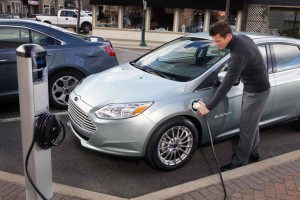
Though several $1,000 more than the Nissan Leaf, Ford hopes to draw buyers to its Focus Electric by pitching the battery car's quick charge times and range of standard features.
With the first of its Focus Electric battery cars set to roll into a select group of California showrooms next month, Ford has announced it will charge just under $40,000 for the vehicle – potentially giving it a leg up on some key competitors.
The Focus EV is part of a wave of battery-based vehicles the Detroit maker plans to roll out over the next several years, including plug-ins and pure battery-electric vehicles. It launched its first battery car, the Transit Connect Electric, late last year. The Focus will be Ford’s first passenger car to run on battery power alone.
“The all-new Focus Electric is an important part of Ford’s overall strategy, bringing still another option to customers who want a car that is fun-to-drive, easy to own and fully electric,” said Chad D’Arcy, Focus Electric Marketing Manager.
Potential buyers now can go online to a special website to configure the 2012 Focus Electric of their choice. The base version will carry a sticker price of $39,200, with destination charges adding another $795. But the battery car qualifies for the full $7,500 federal tax credit available to buyers of electric vehicles.
The 2012 Ford Focus Electric will come in slightly under the price of General Motors’ competing Chevrolet Volt, though Chevy notes that its plug-in hybrid offers a back-up internal combustion engine that permits it to keep going even after the vehicle’s battery pack runs down – typically at around 35 miles a charge.
The Focus EV will cost about $2,000 more than the 2012 Nissan Leaf battery-electric vehicle, meanwhile. While Chevy cut the price of the Volt for 2012 Nissan raised the sticker on the Leaf by $2,420, to an MSRP of $37,250 before destination charges.
Leaf is a dedicated design, the 4-door specifically developed for battery propulsion. Ford instead has chosen to heavily modify its gas-powered Focus, a global compact that went on sale in the U.S. market earlier this year.
Even the base battery version will offer a wide range of features, including an 8-inch LCD touchscreen, the MyFordTouch infotainment system, HID headlamps, Bluetooth and a rear-facing camera.
The Detroit maker also will pitch the relatively fast charging system built into the 2012 Ford Focus Electric, which Ford claims can recharge the vehicle in half the time of the Nissan Leaf. But the Japanese maker plans to upgrade its own charging system next year.
Ford will attempt to market the quick charging and range of standard features in a bid to offset its price disadvantage against Leaf. Industry analysts are still trying to determine just how price sensitive the nascent battery-car market is. It’s difficult to tell because initial demand appears to be driven heavily by so-called “early adopters,” who either want the latest technology or are actively expressing their interest in the greenest available vehicles.
The Obama Administration has been actively promoting battery technology, both on the retail level and by providing extensive financial assistance – in the form of grants and low-interest loans – to battery and battery vehicle manufacturers. The White House has targeted getting more than 1 million such vehicles on the road by mid-decade.
Initial sales are off to a slow start, though demand is beginning to ramp up. Volt sales jumped by 50% in October as General Motors increased production and began offering the plug-in through most of its Chevy dealers in the U.S. As TheDetroitBureau.com reported, Volt is likely to miss its 10,000 sales target for 2011 but GM CEO Dan Akerson said he is confident U.S. production will reach 45,000 next year.
Leaf is also struggling to reach its 10,000 to 12,000 sales goal this year. It appeared to be on track until last month when sales slipped sharply. (Click Here for more on Volt and Leaf.)
Ford will follow a similar marketing strategy to Chevy and Nissan, initially offering the 2012 Focus Electric only in California before adding other markets in the spring of 2012.
